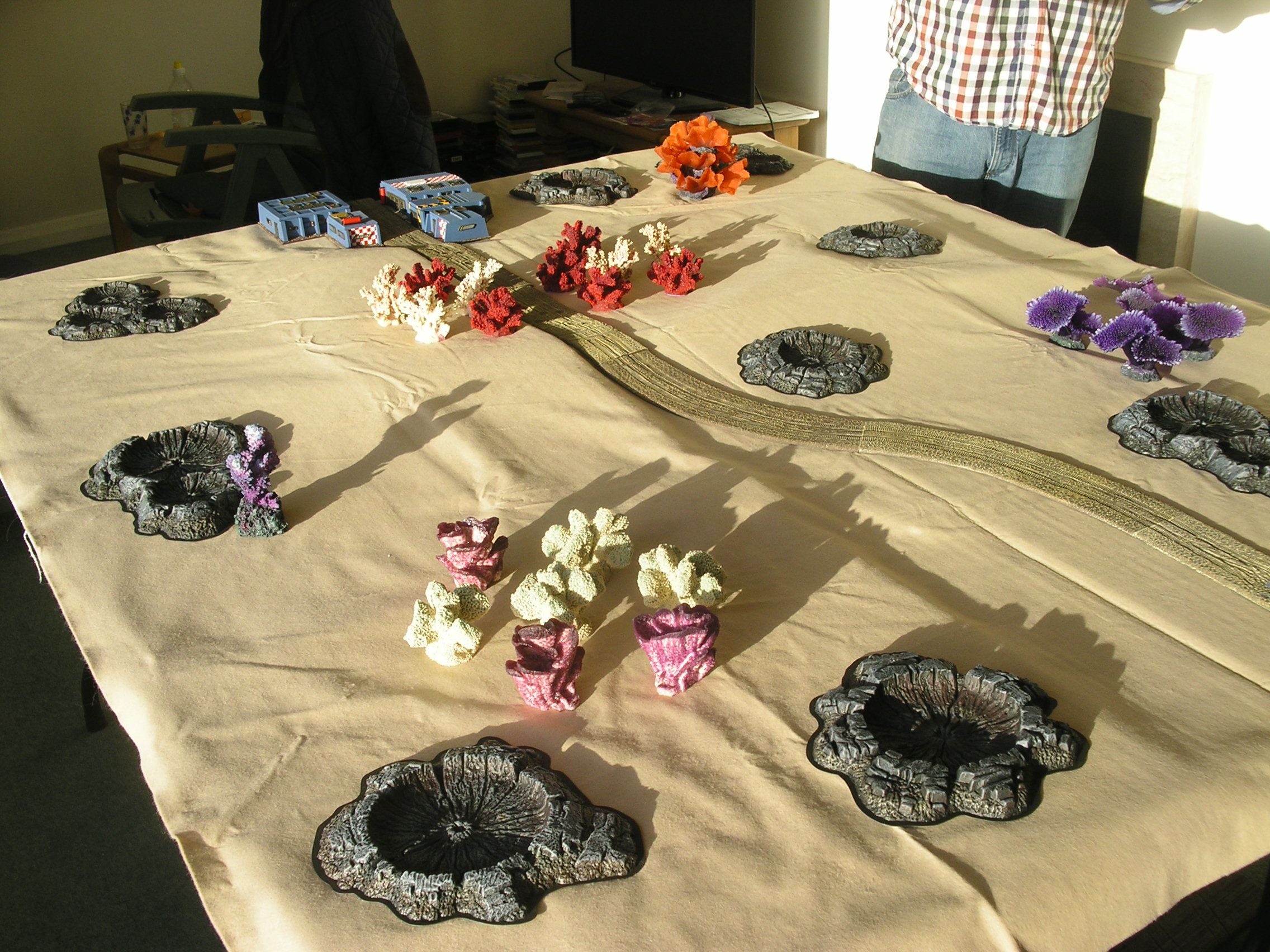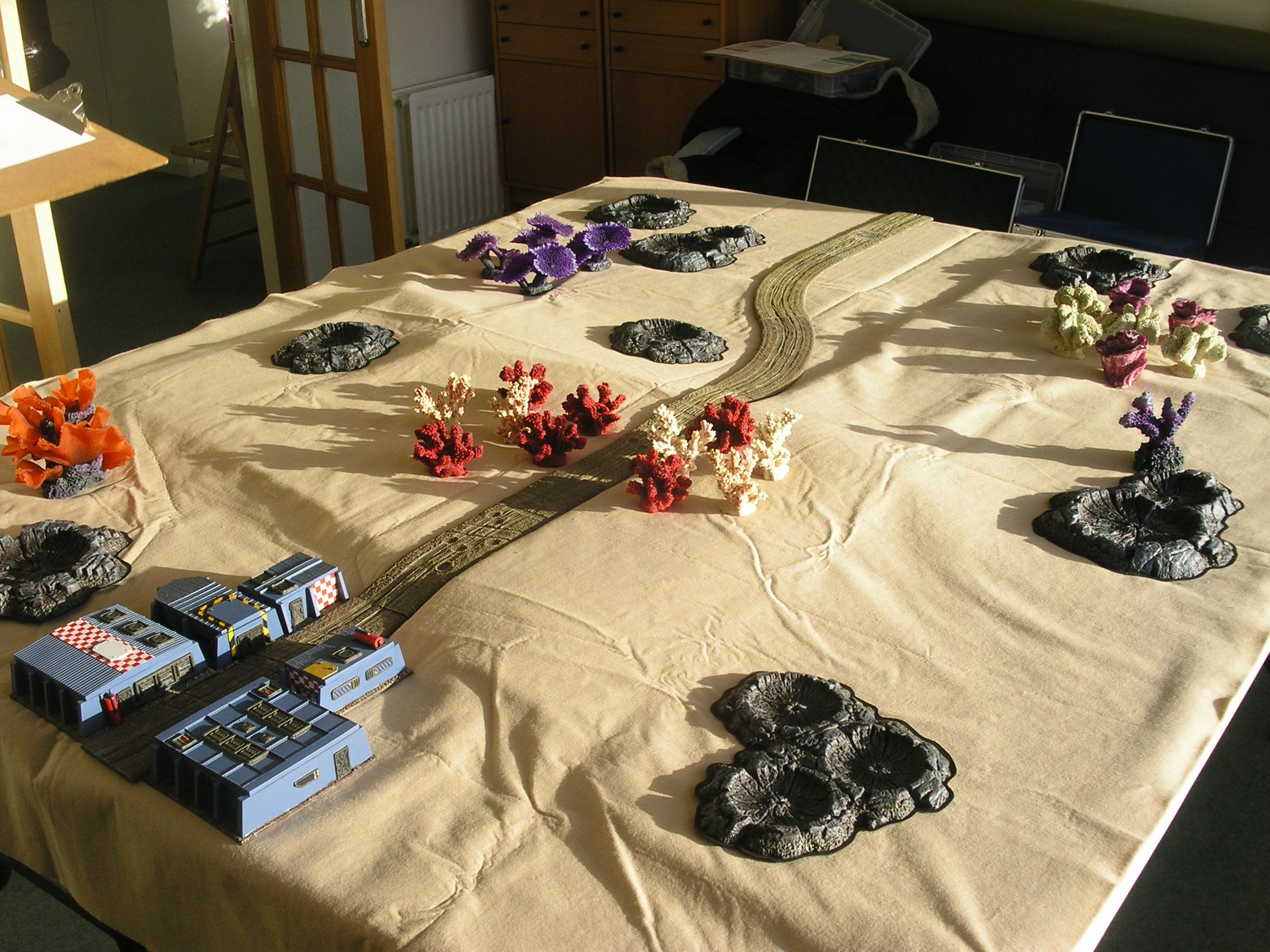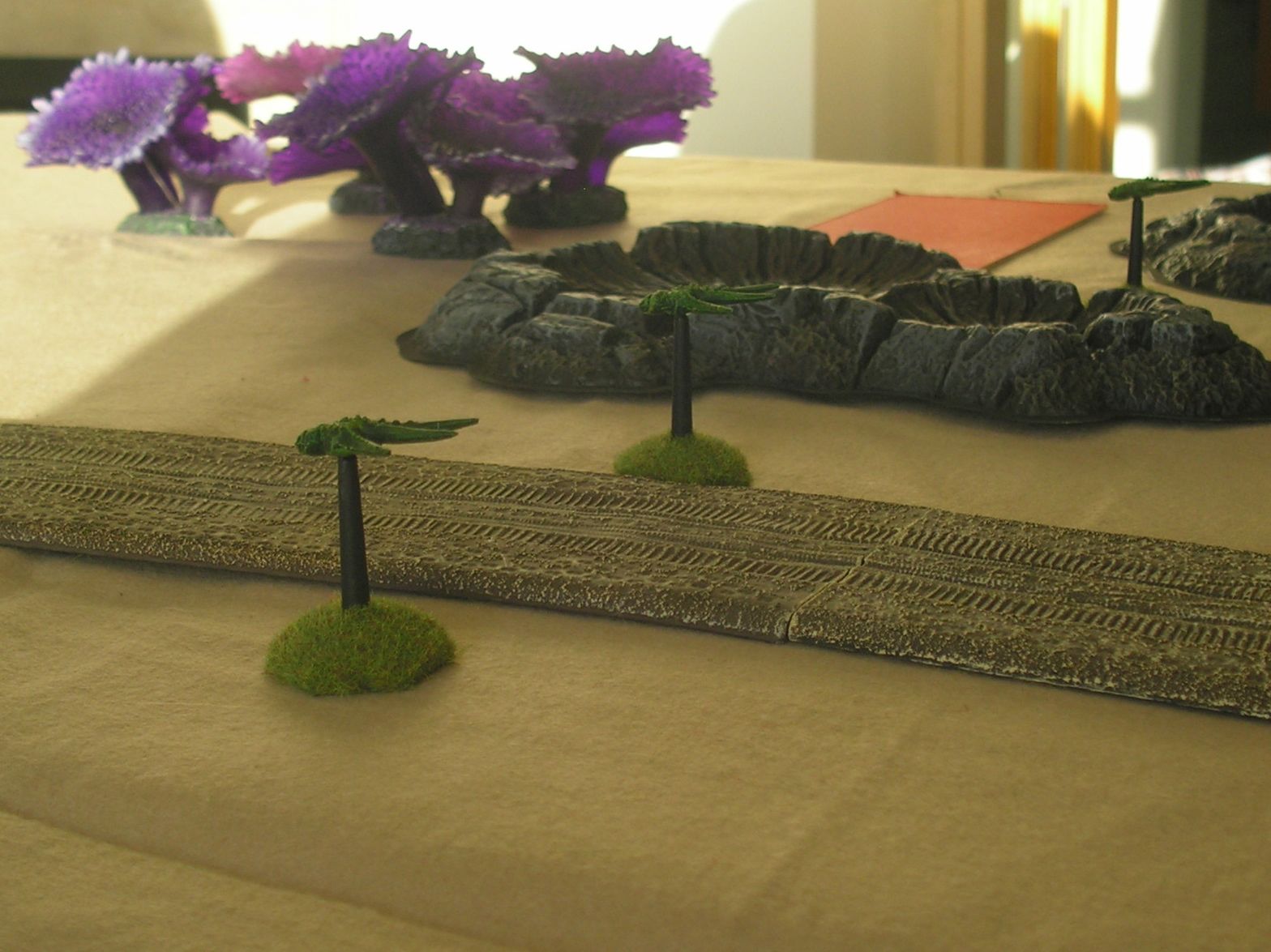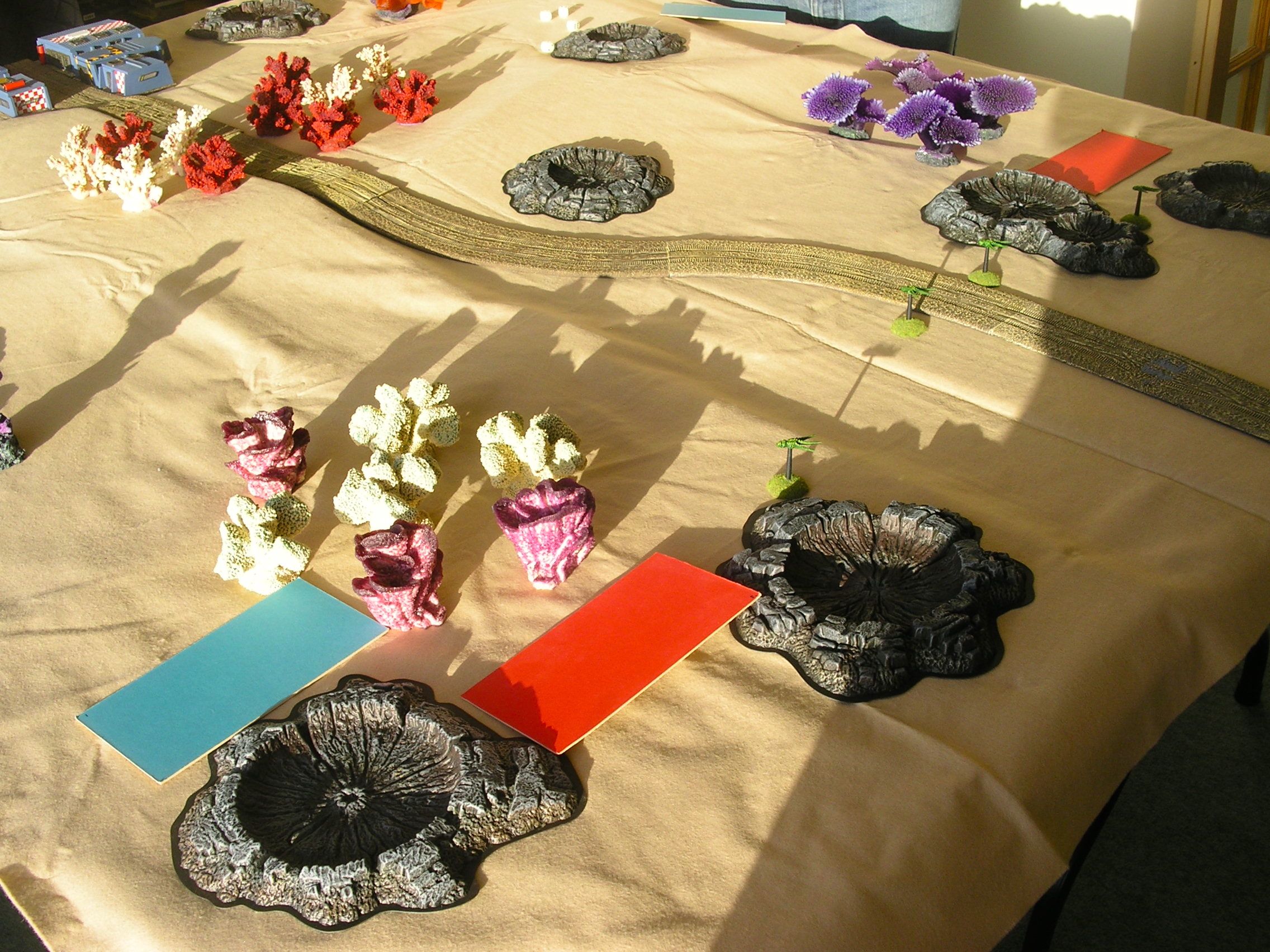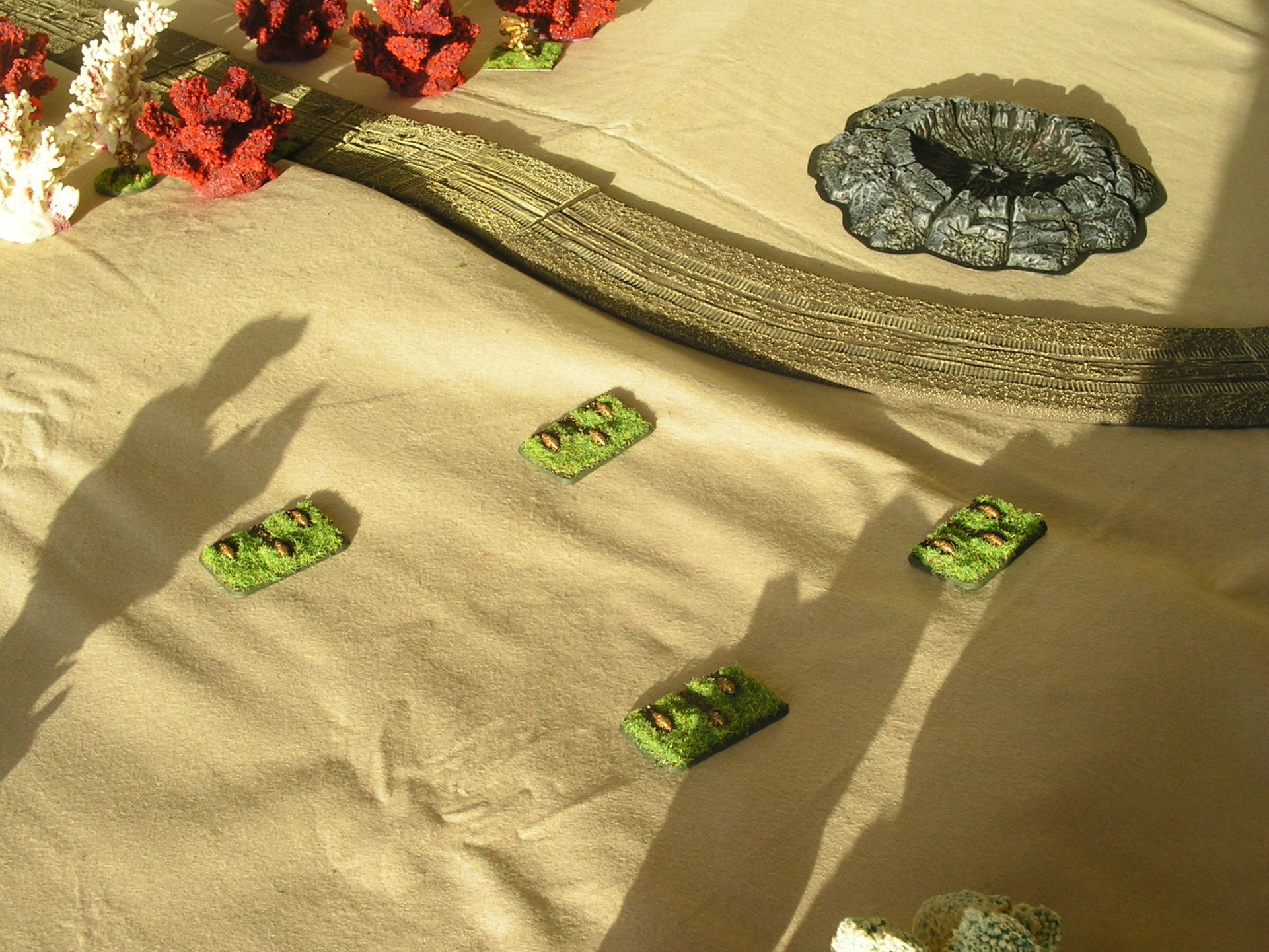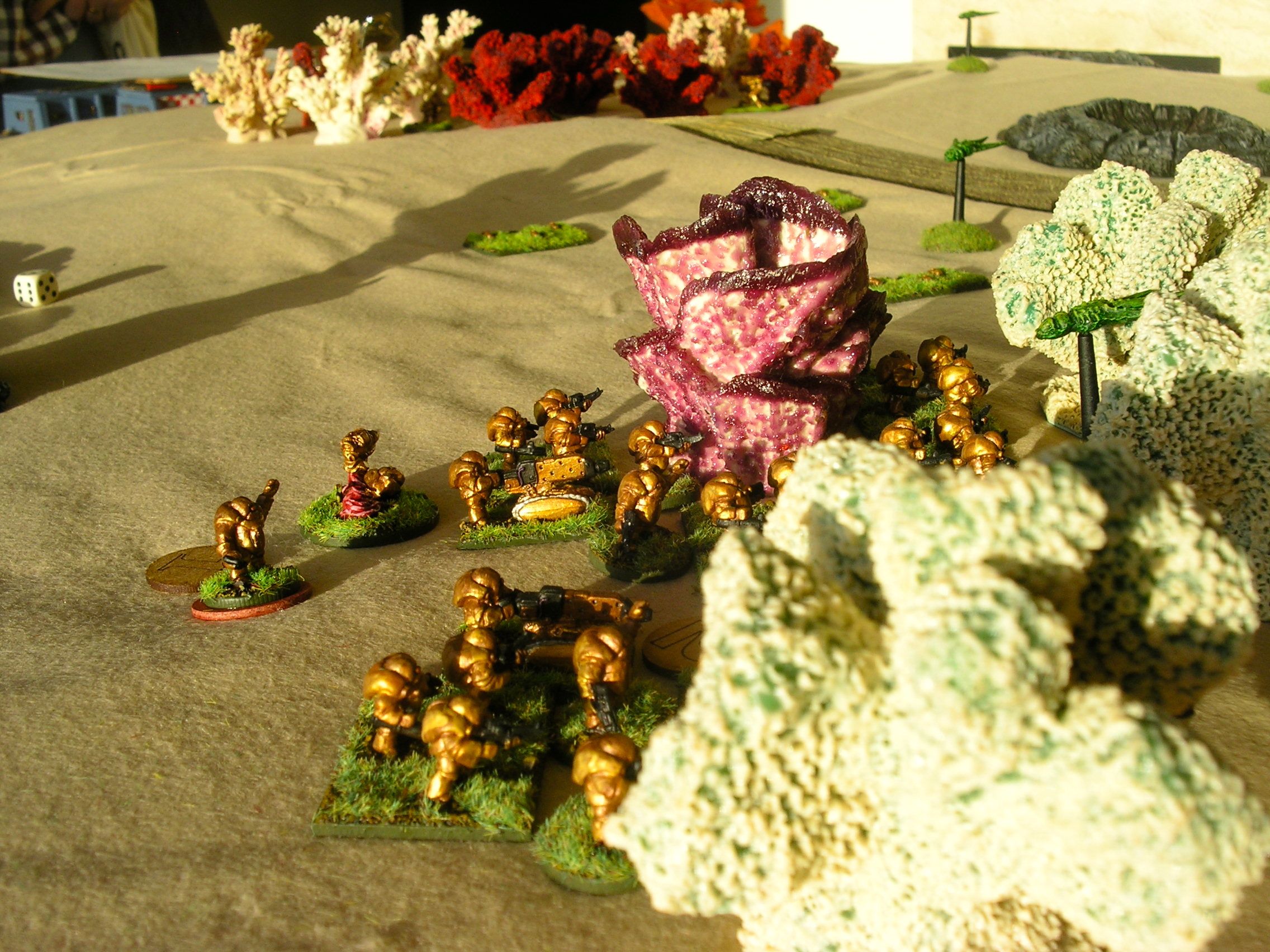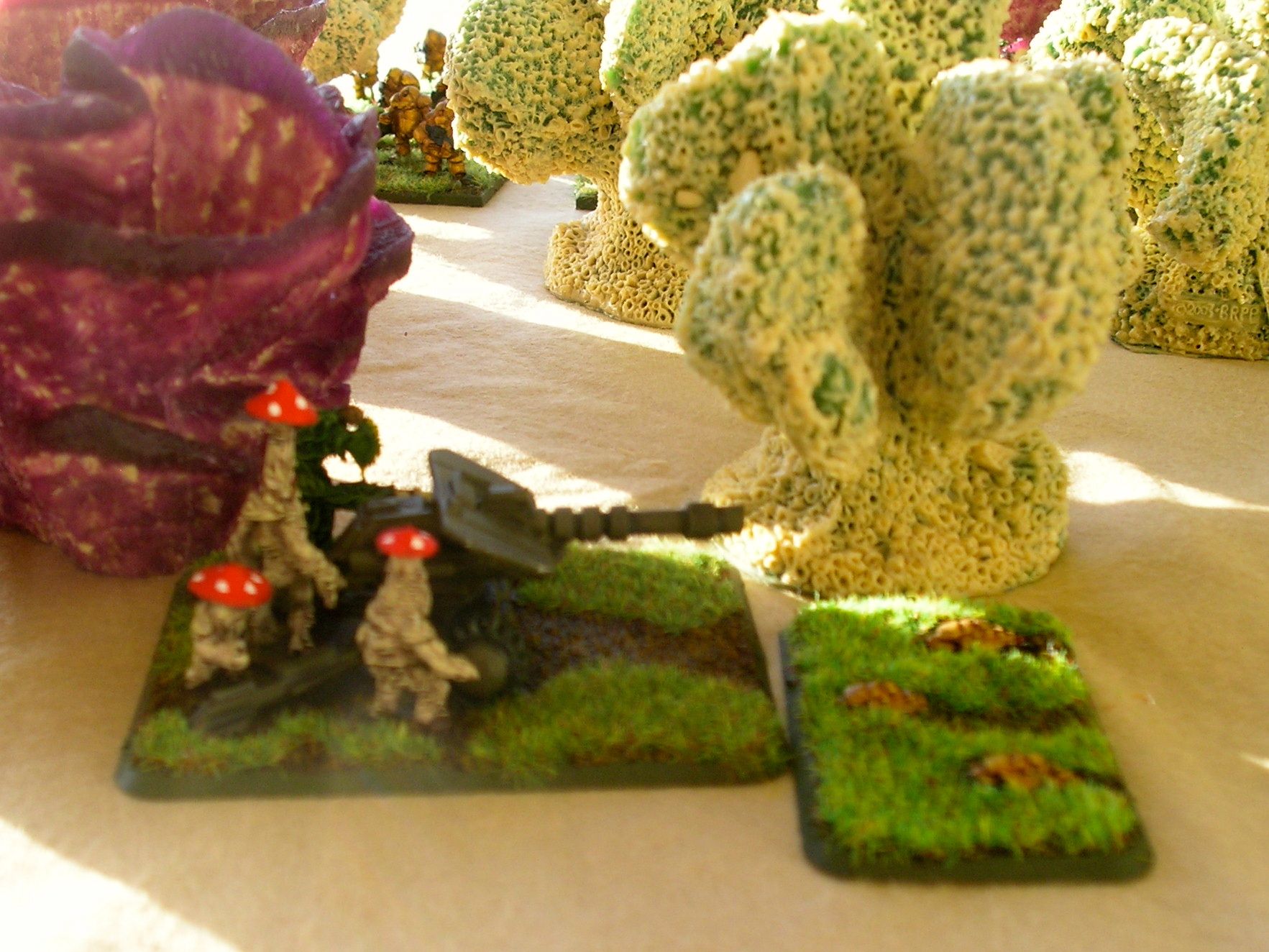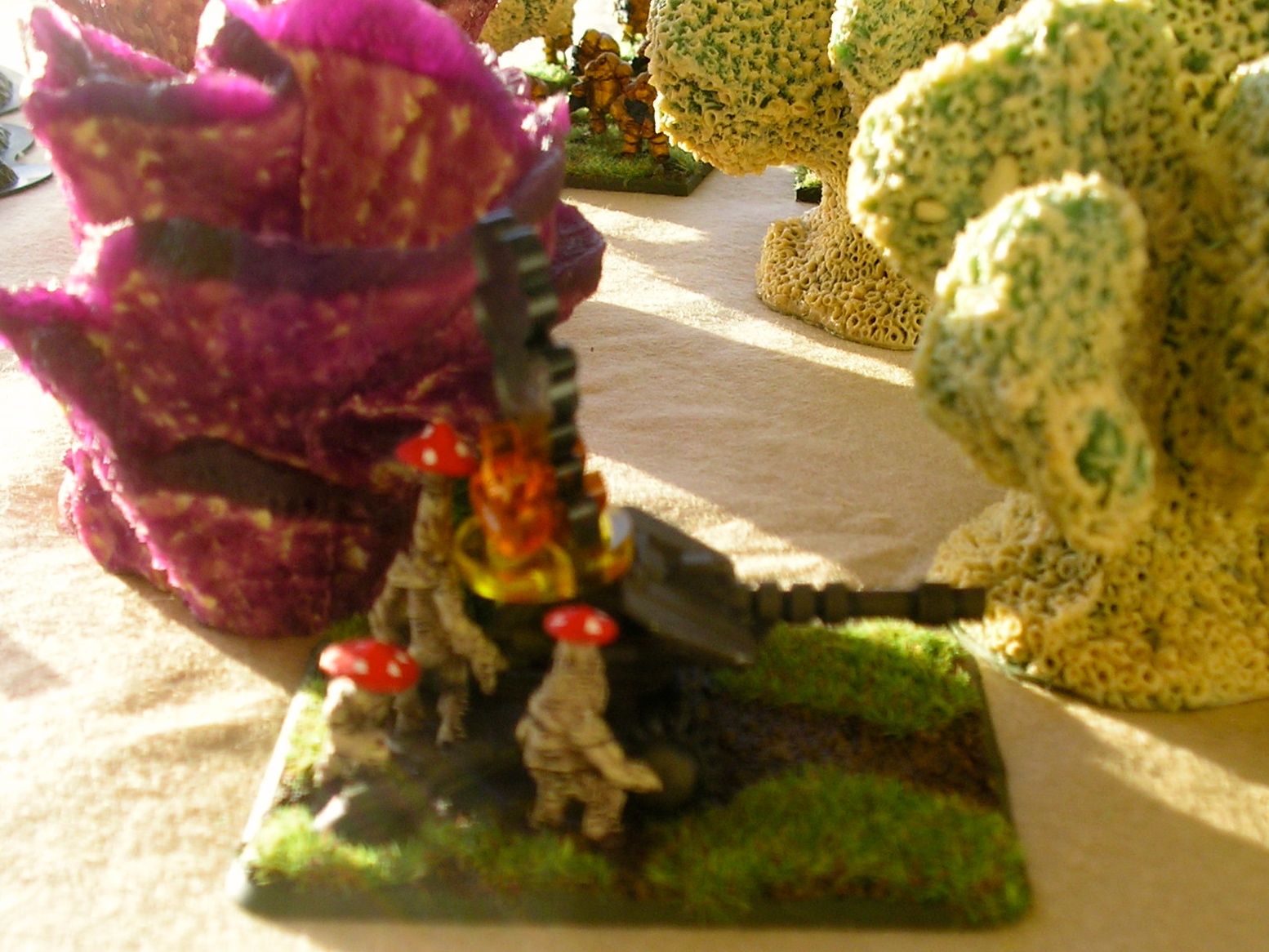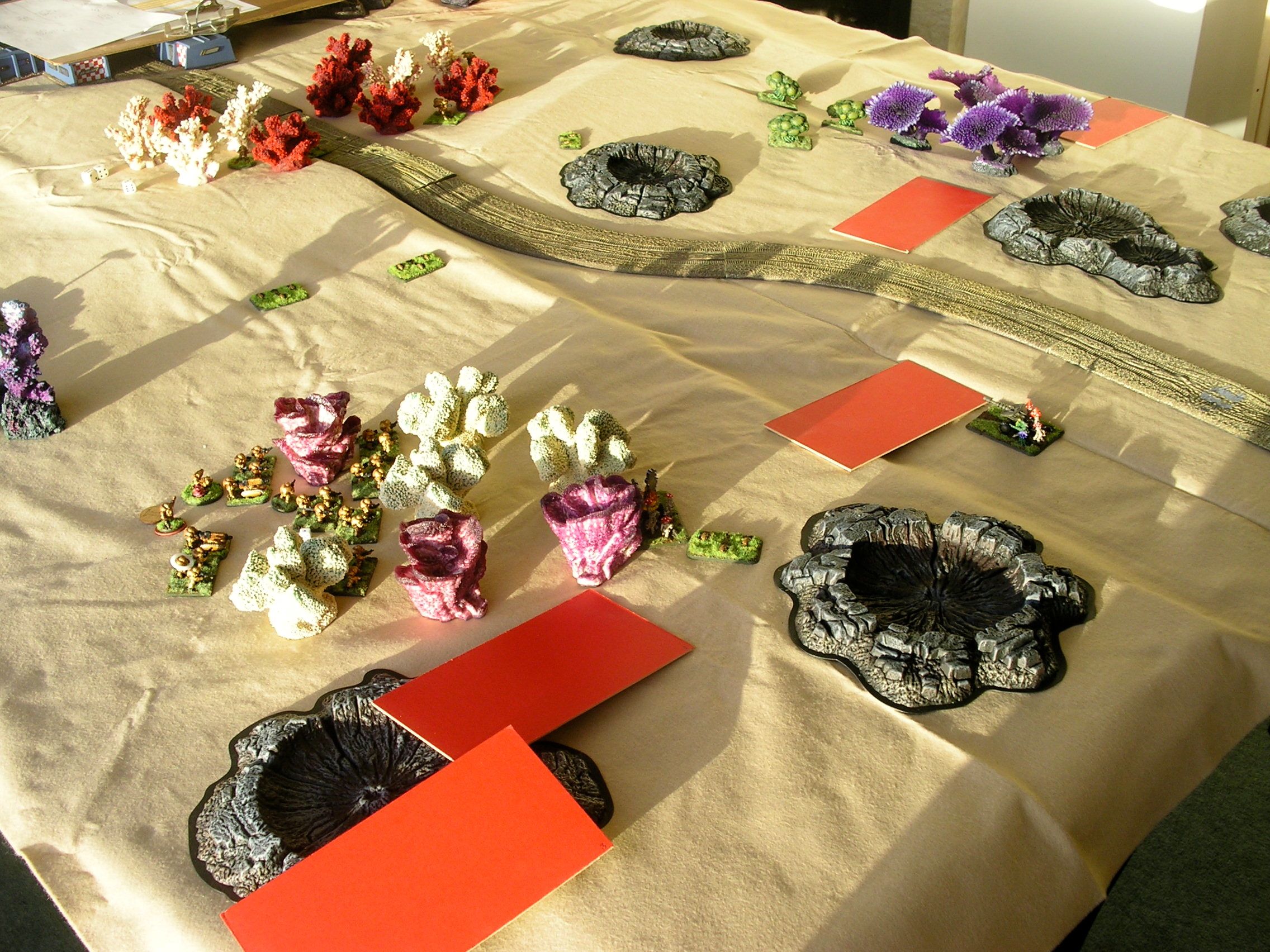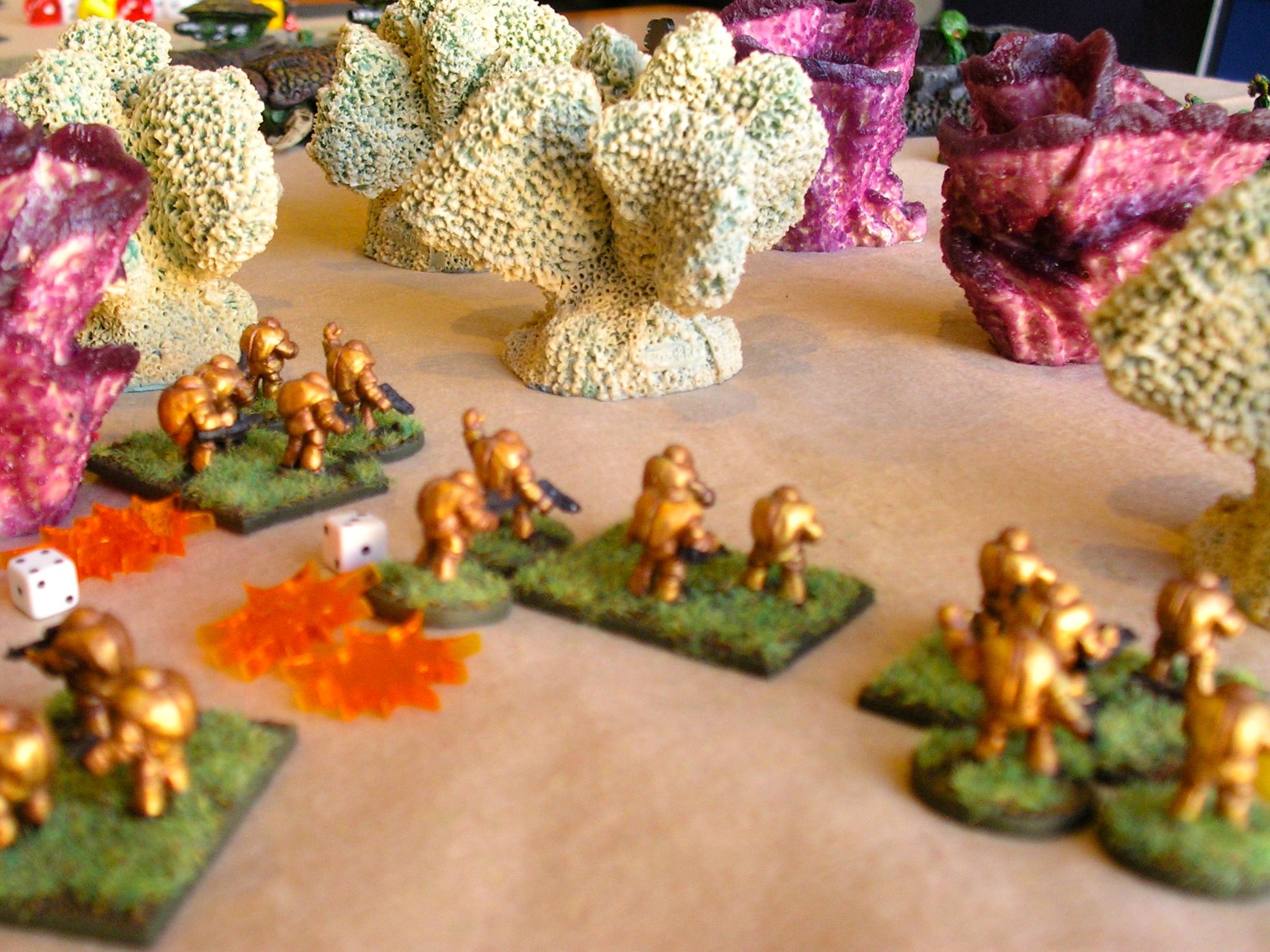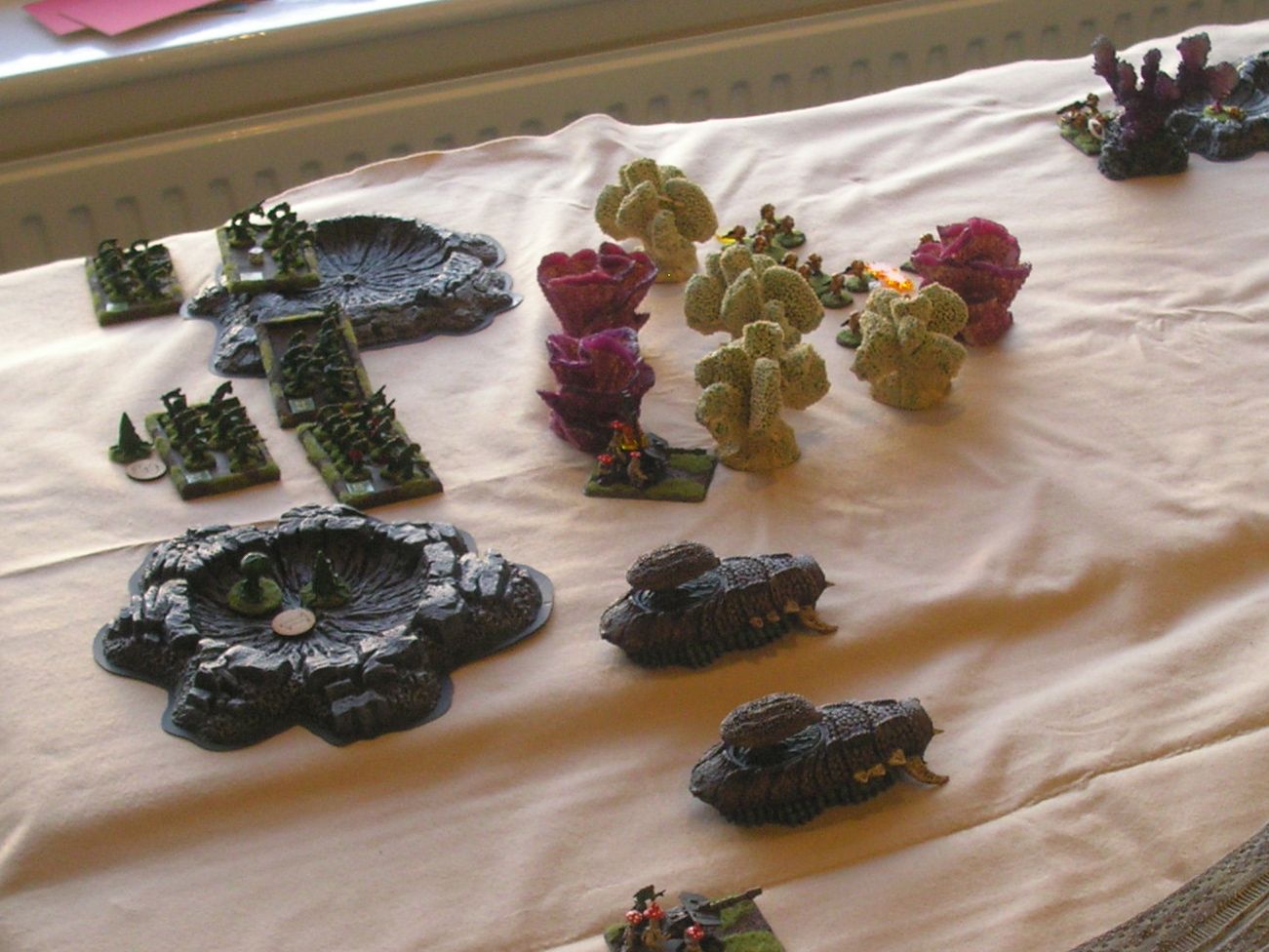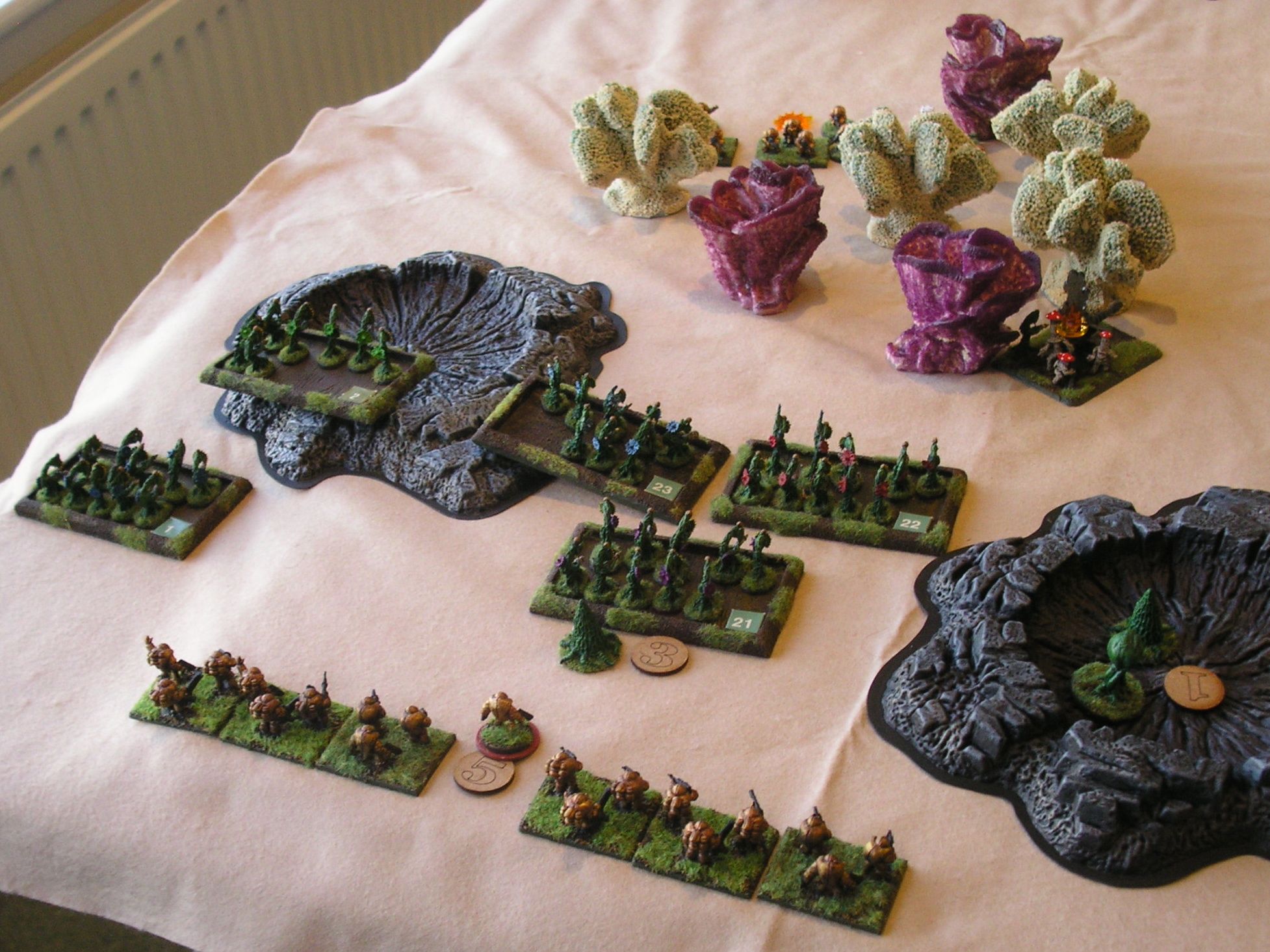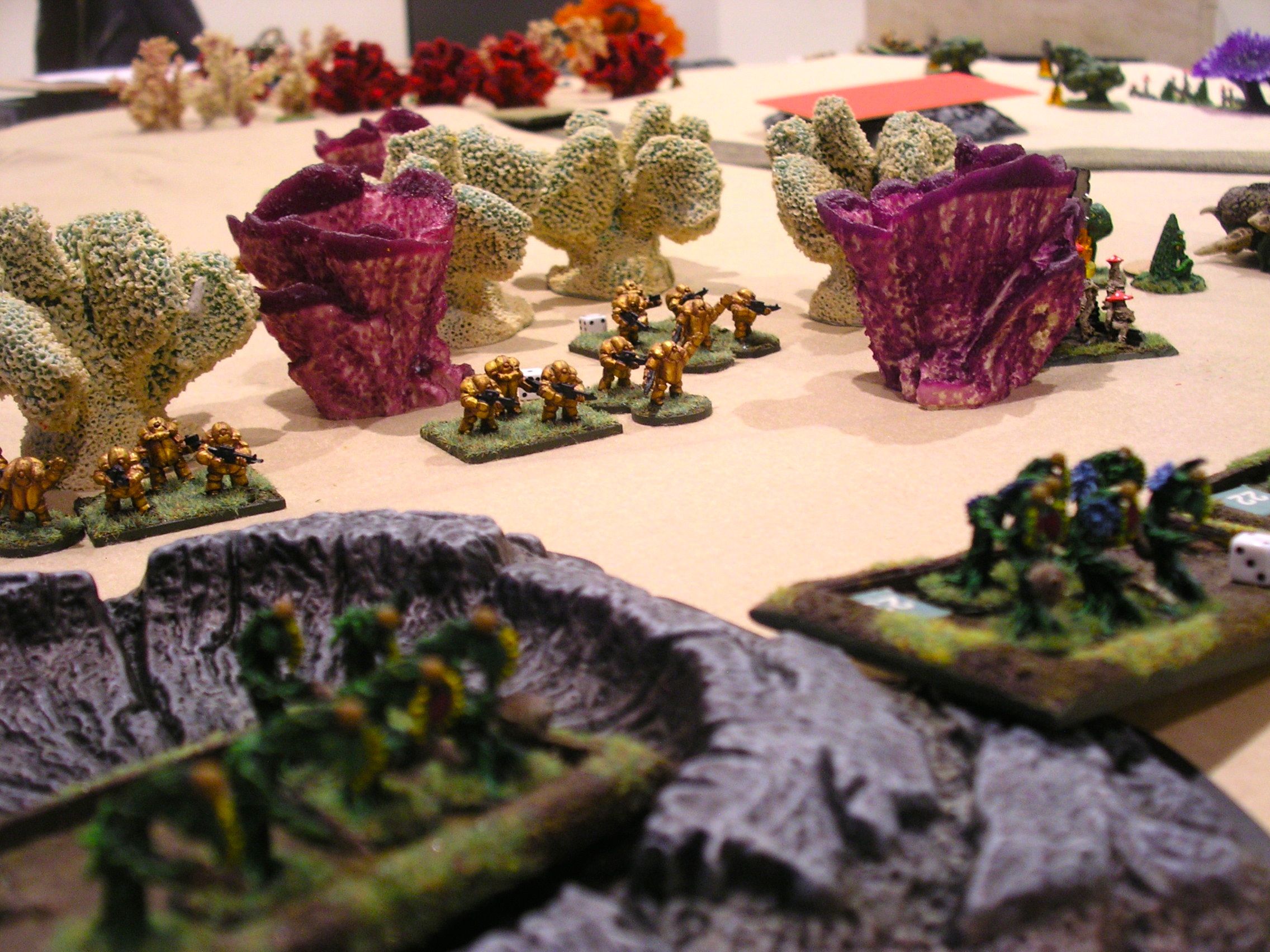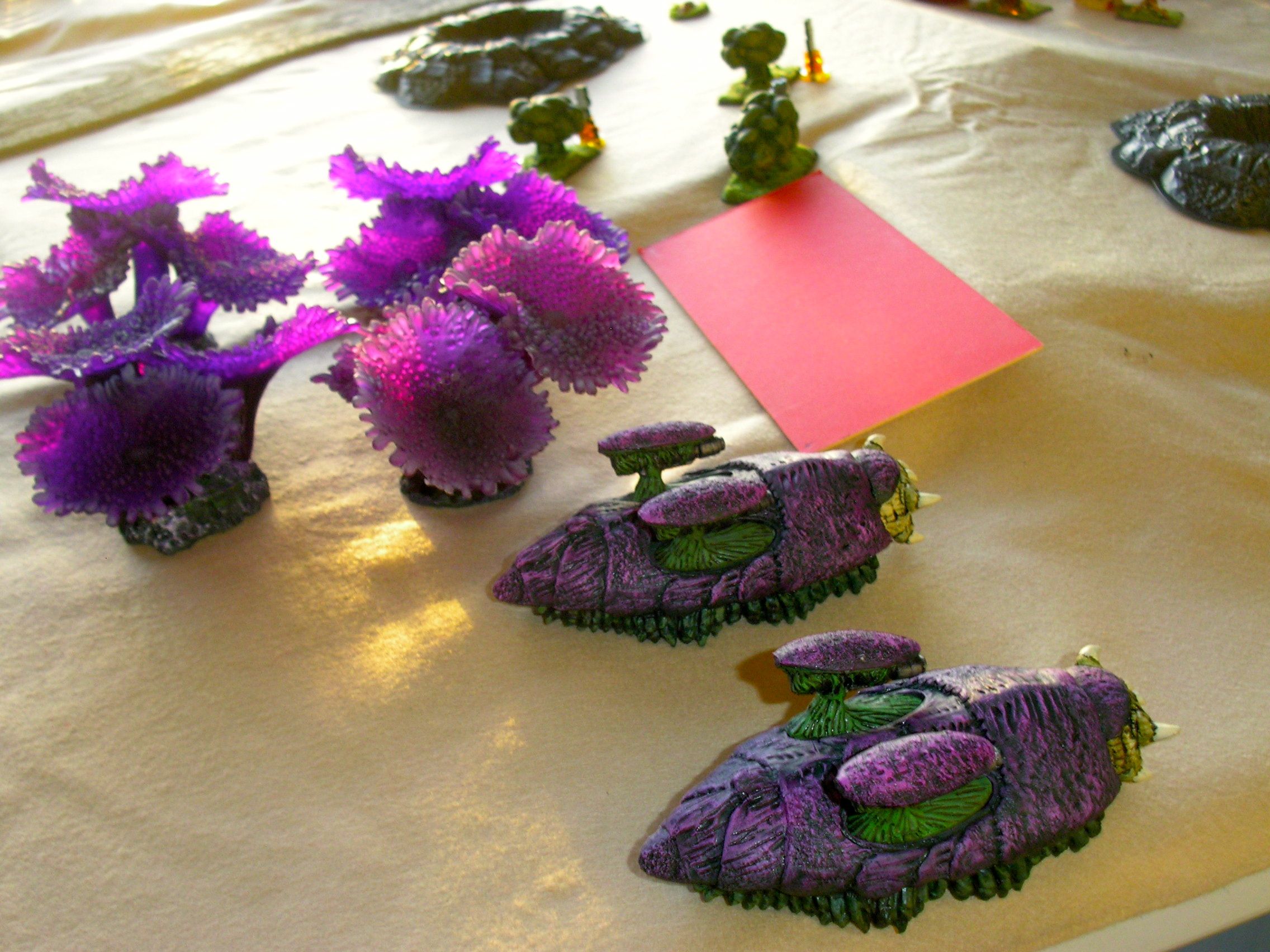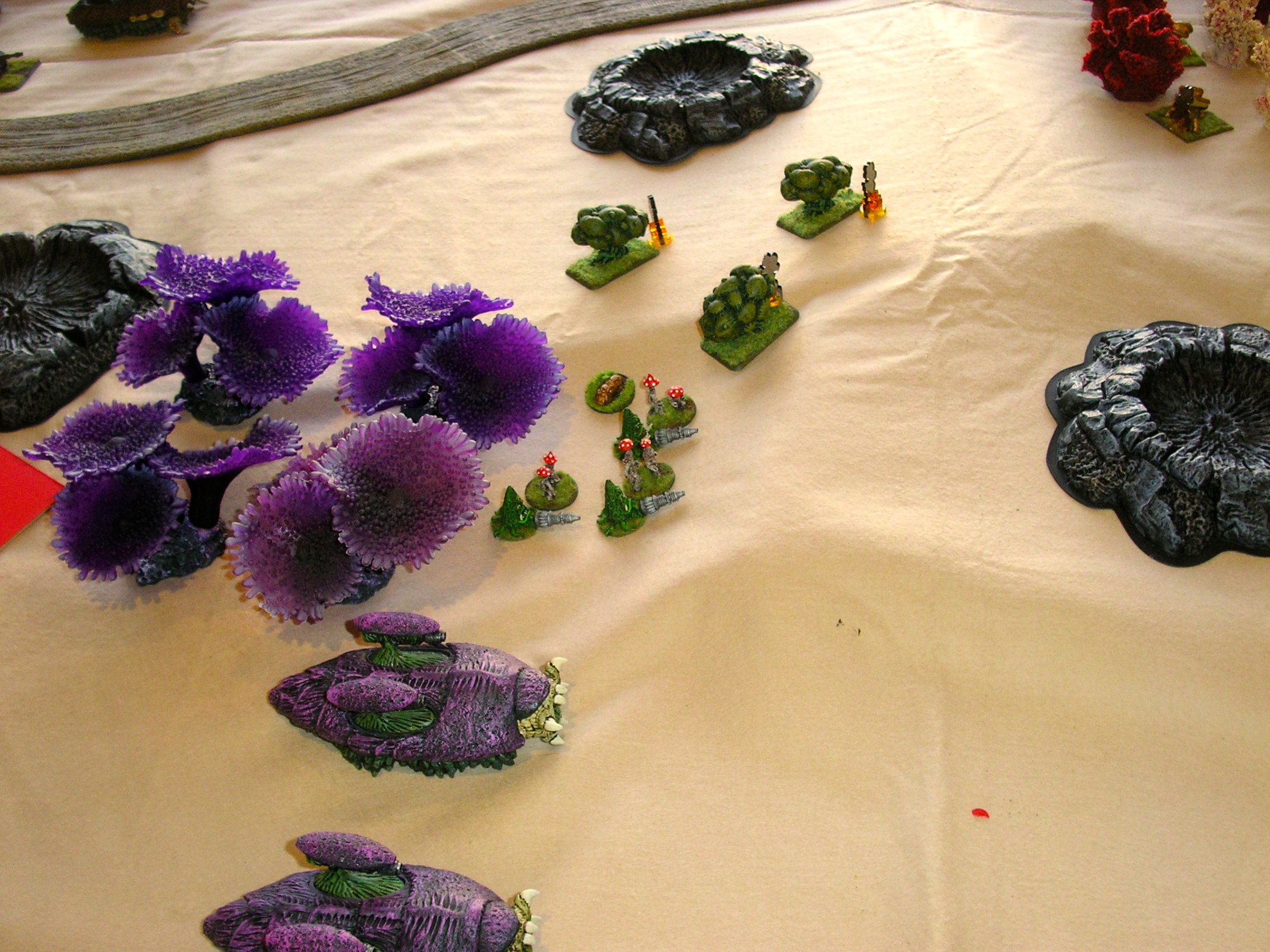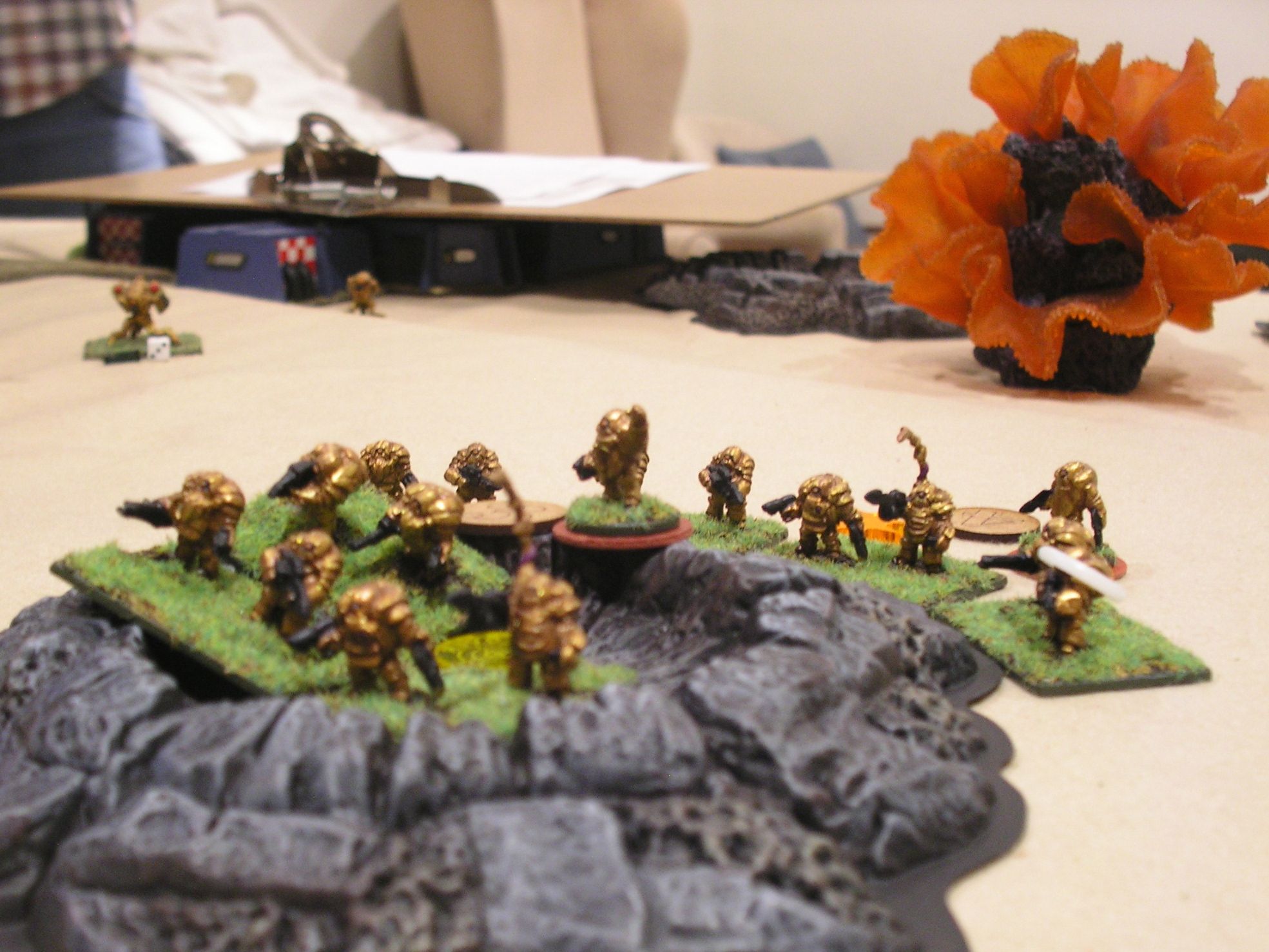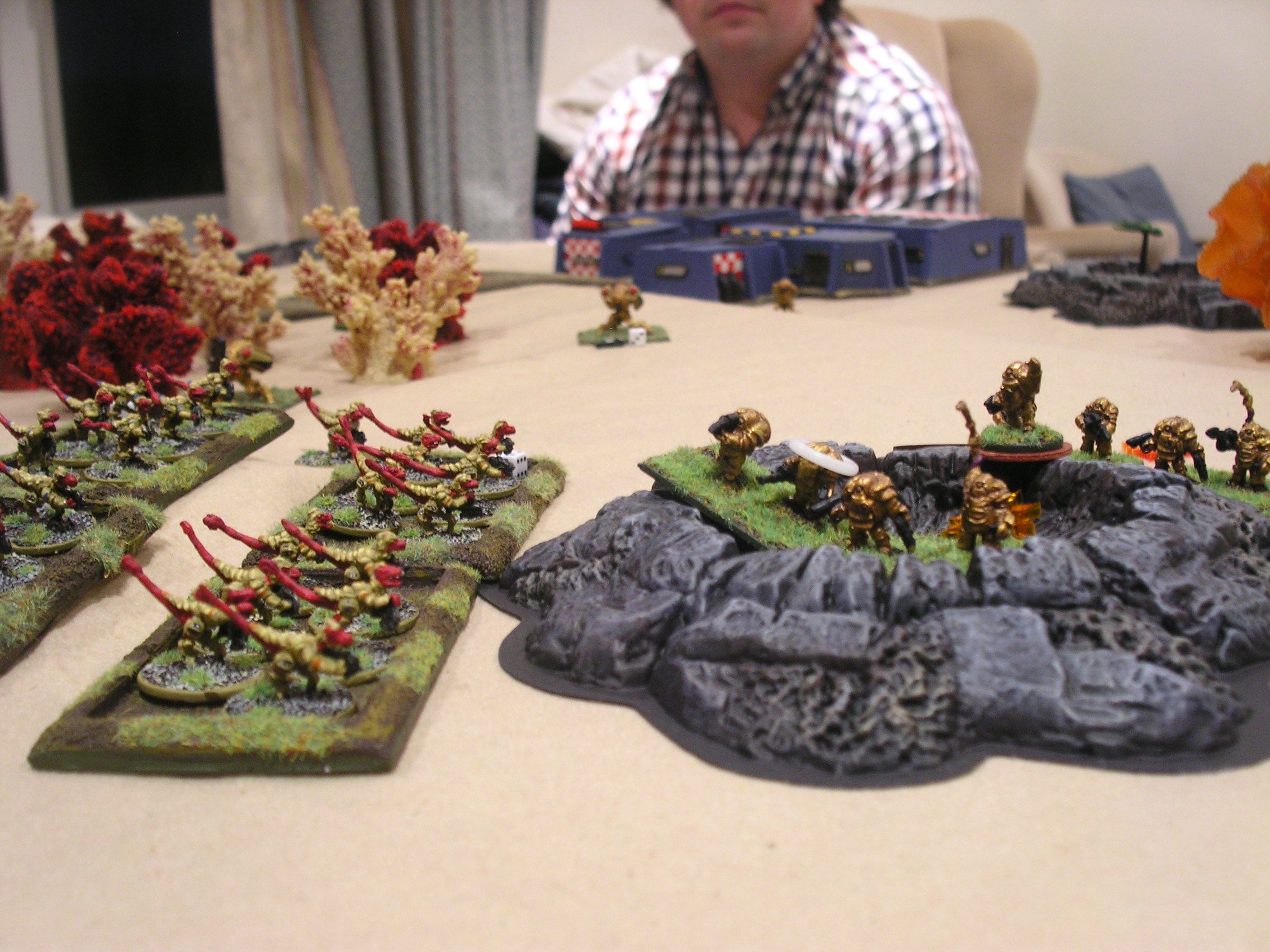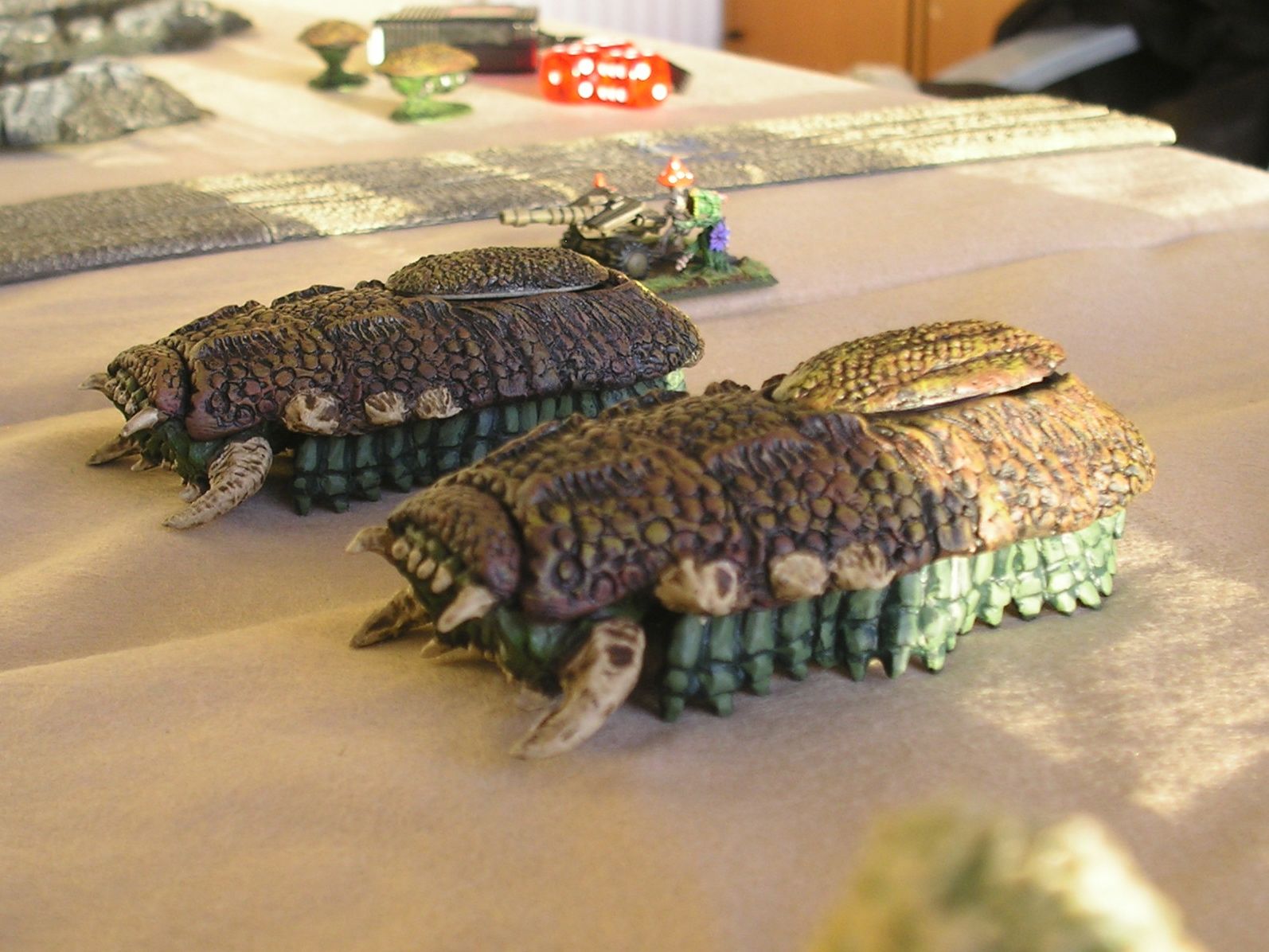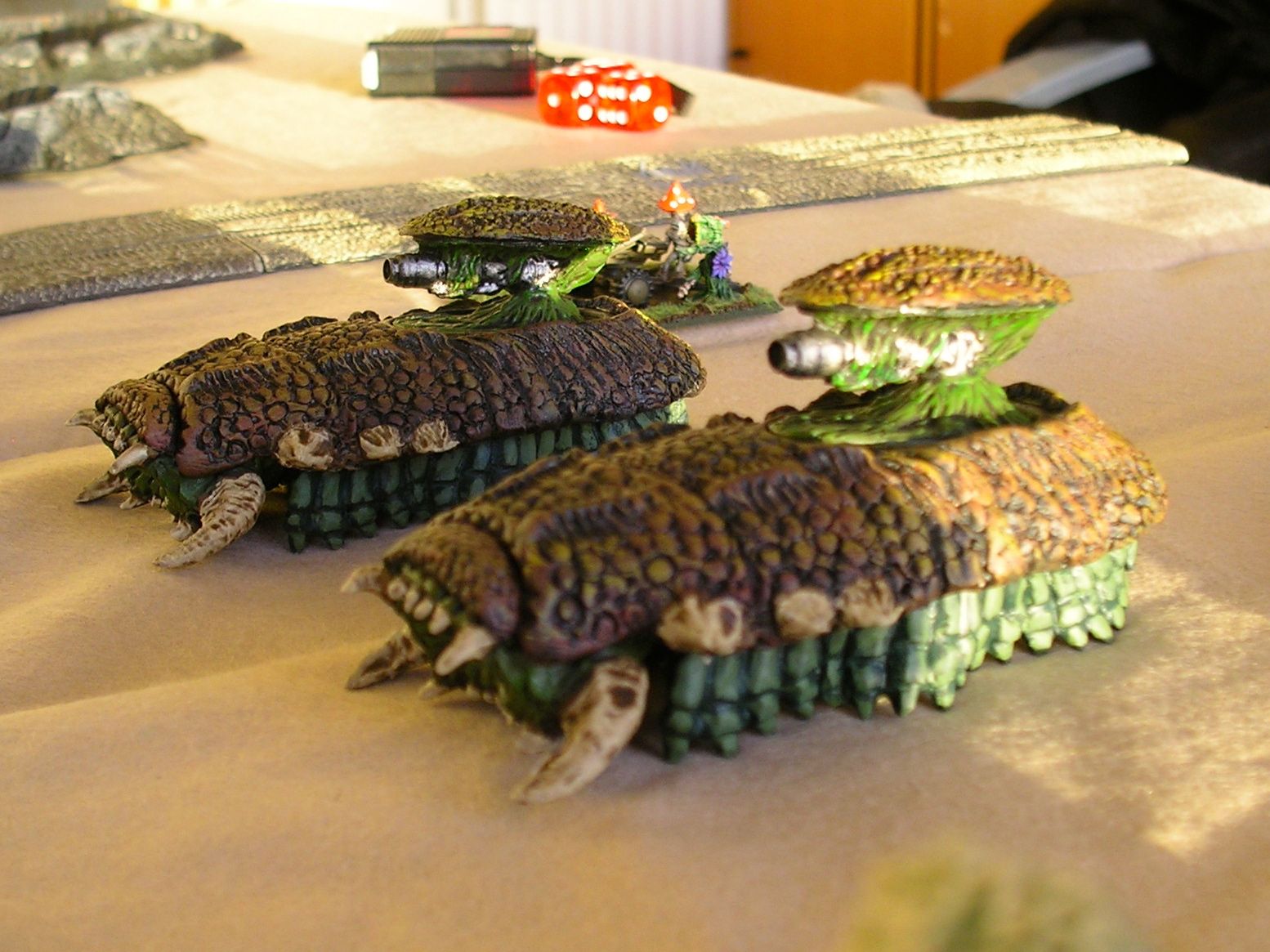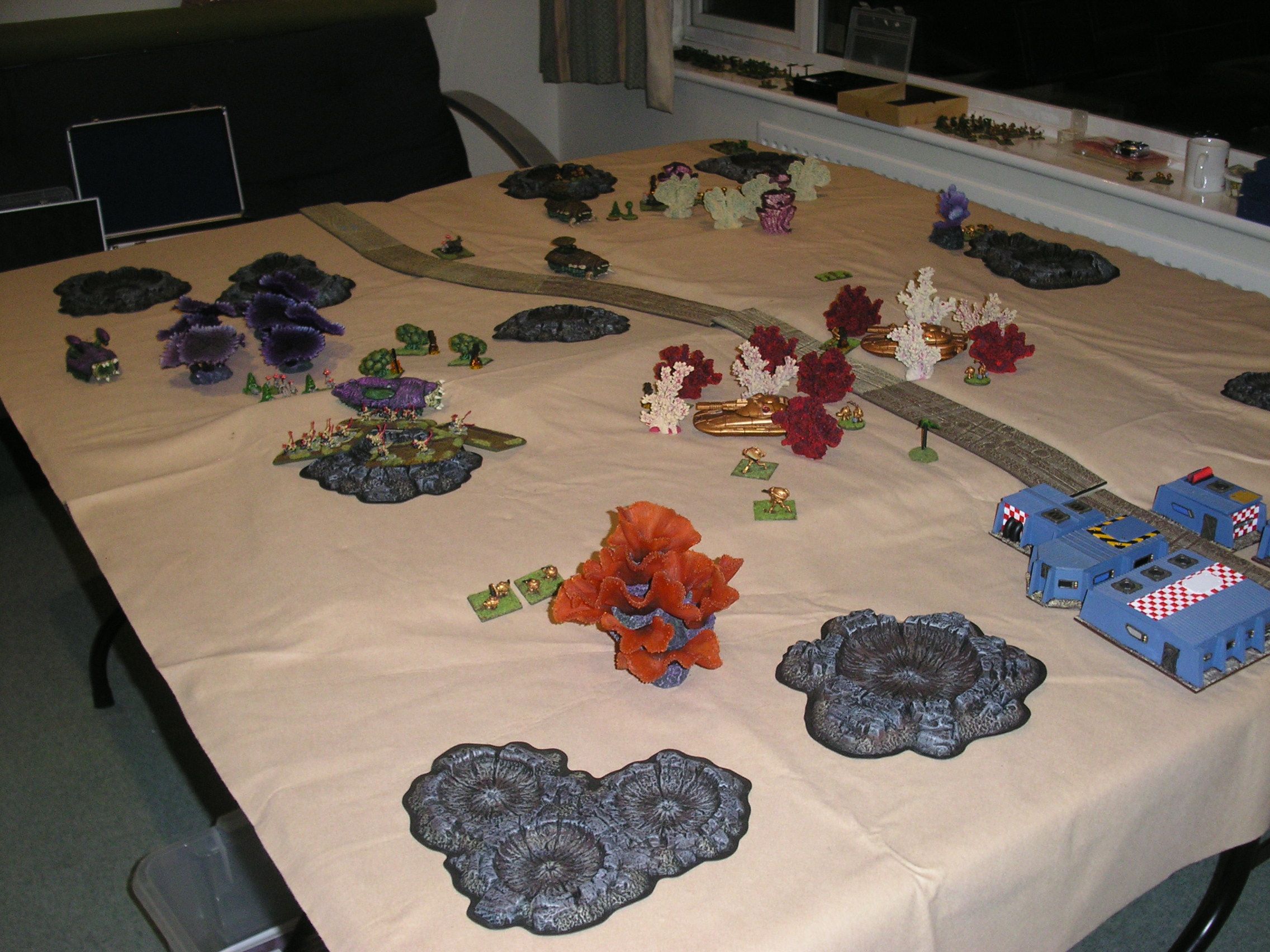My first game of the year was an epic 15mm sci-fi clash between my newly painted Gitungi army, using figures mostly from Micropanzer’s Gitungi range, and an ‘evil vegetable’ army comprising figures from a number of different manufacturers but principally Khurasan’s Vornid plant-men and Ravenstar’s Horrids. As Neil, my opponent, immediately declared that he was “not going to play the toadstools”, I would field the Veg and he, obviously not being a fun guy (boom, boom!), would play the Gitungi.
As can be seen in the pictures below, the table represented an area of ridged ground speckled with craters. There were also a number of areas of ‘wooded ground’ where alien vegetation (aquarium decorations from Pets at Home) would provide good cover. A road led from one end of the table to the other, ending in a small collection of buildings (from Critial Mass Games) control of which were both sides’ objective.
the table from the gitungi (defending) end
The table from the Veg (attacking) end
The Gitungi were defending the buildings and would therefore start the game on table under Hidden Blinds. At their disposal they had:
- two platoons of armoured infantry (one regular, one veteran)
- a unit of two superheavy tanks
- three independent anti-armour cannon teams
- one assault cannon drone unit (two drones)
- one missile-launcher drone unit (two drones)
- one gene-recovery drone (a medic)
- three drone operator teams (to operate the drones and carry out other electronic warfare tasks)
- one mole-mine operator (to operate a number of mole mines: effectively guided land torpedoes)
The Gitungi would also receive reinforcements after four turns: a platoon of elite but lightly armed scouts that would arrive using jump-packs and the battlefield insertion rules.
The Veg would enter the table from the side opposite the buildings. Their force consisted of:
- one Horrid Scanner (electronic warfare)
- three platoons of Vornid infantry (heavily armed but with no armour)
- a unit of two one-gun Horrid tanks
- a unit of two two-gun Horrid tanks
- a unit of three Horrid airbags (floating balloons that spit napalm!)
- a unit of four unarmed drone scouts
- a unit of three Slishian HMG gunners with Fungi crew
- a unit of two anti-tank guns with Vornid/Fungi crew
- a platoon of Chuhuac mercenaries (velociraptors with guns)
For those interested, the Vornid and Fungi are from Khurasan; the Horrid from Ravenstar; the Slishians are from Hydra; the Chuhuac from Loud Ninja Games; and the drone scouts and anti-tank guns from GZG. That’s the beauty of Q13: you can build your own armies out of multiple figure ranges and a bit of imagination!
The Game
The battle began with the Veg’s drone scouts sweeping onto the table. Gitungi electronic counter-measures kept them from being able to scan the whole battlefield, but they still managed to establish that the first foot or so of the table was clear of enemy troops lying in ambush, so on came the first Veg blinds (the red rectangles).
Veg scouting drones sweep in
gitungi blind appears!
Almost immediately, a Gitungi blind (the blue rectangles) appeared from the shell crater mid-right of the battlefield, and headed towards the Veg blind on their left. At the same time, the Gitungi mole-mine specialist revealed his position in the ‘wood’ in front of the target buildings, and sent a wave of medium sized mole-mines forward towards the Veg end of the table.
here come the mole-mines (note operator top left)
gitungi platoon spotted (note veg scouting drone centre right)
One of the Veg scout drones flew right over the Gitungi blind coming forward, revealing it as their standard infantry platoon supported by a couple of anti-armour cannon teams. As it happened, the Veg blind opposite was also a platoon of infantry supported by the anti-tanks guns, which moved forward looking both to engage the enemy asap and to keep the Gitungi platoon from establishing a good base of fire in the ‘wood’.
Unfortunately for the Veg, the first of the mole-mines then arrived. Tunneling just under the surface, the mine exploded underneath one of the Veg anti-tank guns, destroying the gun and killing its crew. Worse, there was another just behind that was heading for the Vornid infantry platoon moving forward into the ‘wood’.
the first mole mine arrives...
the result!
After much deliberation, the Veg decided that the lesser of two evils was to avoid the mole-mine by charging forward into the ‘wood’ and attempting to close combat the Gitungi platoon entering the vegetation from the other side.
Whether this was actually a lesser evil than having a mole-mine explode underneath them is debatable, as the Gitungi platoon was able to repel their assault fairly easily: losing only six men and driving what little remained of the Vornid platoon off the table in a rout.
This obviously left the Gitungi platoon in a prime position: in cover on the flank and rear of most of the Veg troops that were on the table. The Veg obviously couldn’t ignore them, so committed both their remaining Vornid infantry platoons to wiping the enemy platoon out.
vornid infantry (the two blinds bottom left) advance
gitungi platoon taking heavy fire
Initially everything went well. The Vornid infantry advanced forward and prepared to overwhelm their now severely outnumbered enemy.
Unfortunately, as time had been passing, so had the Turn Cards, and the Gitungi scout platoon reinforcements, with jump packs, now arrived. Under the battlefield insertion rules, the platoon could arrive anywhere on the tabletop: Gitungi player’s choice plus deviation similar to artillery strike deviation.
You guessed it: the scout platoon arrived on the table’s baseline, right behind the line of advancing Vornid infantry!
vornid infantry in a commanding position
surprise! THE SCOUTS ARRIVE
Arriving from the skies in a cloud of smoke and dust, the Gitungi scouts immediately opened fire into their enemy’s rear, doing heavy casualties to the advancing Vornid platoons. Fortunately there were a lot of Vornid there (two platoons totalling 50 plant-men in all), so when the numerous survivors then turned and opened fire back on the much smaller scout platoon (only 18 Gitungi strong), the scout platoon was halved in numbers.
The Vornid were, however, now caught in a sandwich between the scouts and the original Gitungi infantry platoon, and were appropriately hammered as a result. At the end of the game the Vornid infantry force, originally 80-strong in three platoons, was down to just 21-strong in three squads. Admittedly, the two Gitungi platoons, originally 42-strong, were now down to half strength, but they were in a much better tactical position and, at any rate, were the defenders: there was no way that the remaining Vornid could still be considered a threat. One other significant factor in their defeat, incidentally, was that the Gitungi drone operators had been jamming the Vornid commander’s communications, meaning that ‘he’ hadn’t been able to co-ordinate or rally his plant-men throughout the action described above.
VORNID TAKING FIRE FROM THE FRONT...NOW THEIR REAR!
GITUNGI INFANTRY IN COVER HAMMERING THE VORNID INFANTRY
Meanwhile the rest of the Veg force had been advancing up the table towards the Gitungi-held buildings. One thrust focused on the right-hand side of the battlefield; one, slower, thrust, up the centre.
On the right, the Horrid Airbags were out in front, and were quickly spotted by the Gitungi troops in the central ‘wood’. Although two Airbags were quickly destroyed, the third managed to get close enough to napalm-spit one of the Gitungi missile drones, frying every circuit and leaving it a twisted and blackened ruin.
That Airbag was soon destroyed, but following up were the two-gun Horrid tanks, the Slishian gunners and the Chuhuac mercenaries. The advance halted for a moment as the tanks began a duel with the remaining drones in the central ‘wood’, eventually destroying one of the two assault cannon drones and driving the two remaining drones back behind cover.
The tanks had also managed to destroy a Gitungi anti-armour cannon with some well-placed indirect fire (although one of them had lost one of its main guns to another molemine strike) and were now poised to move forward again when the Veg scout drones reported that the crater in front of the tanks contained a platoon of Gitungi infantry (the veteran platoon). The tanks started shelling the crater, pinning or suppressing the enemy infantry but not actually killing many of them as their cover and superior quality armour soaked up so much damage. They would have to be winkled out the old-fashioned way!
In went the Chuhuac mercenaries, also armoured, and a huge armoured-infantry melee took place that left the sorry remains of the Gitungi veteran infantry platoon retreating back towards the buildings on their baseline.
GITUNGI VETERAN PLATOON
IN GO THE CHUHUAC MERCENARIES
Unfortunately, one of the Gitungi superheavy tanks then pushed through to the edge of the central ‘wood’ and let the victorious Chuhuac platoon have it as they were re-organising after the melee.
The Horrid tanks quickly opened up on the superheavy tank, but the damage was done. The Chuhuacs had been pretty severely bashed up and were checking the exit terms of their contract!
As all this was going on, the Veg’s central thrust, led by the two one-gun Horrid tanks, had also got bogged down: having to deal with more mole-mines, the other two anti-armour cannons, helping out the Vornid infantry, and then finally running up against the other Gitungi superheavy tank, positioned in the other half of the central ‘wood’.
HORRID ONE-GUN TAnKS, GUNS HIDDEN
HORRID ONE-GUN TANKS, GUNS DEPLOYED (MODELS FROM RAVENSTAR)
The Veg attack had more than stalled. Although they still still outgunned the Gitungi by four tanks versus two, they had effectively run out of infantry and the two Gitungi tanks were superheavy monsters and owned a very strong central position in cover. Neil and I estimated that if the current firefights took their course, the Gitungi would be left with a two thirds-strength platoon of infantry and a couple of drones…but the Veg would be advancing forward with one one-gun tank! The Gintugi were declared the winners, with the remaining Veg fading away into the undergrowth.
THE END!
It had been a great game where the advantage swung backwards and forwards between the two sides. The key Gitungi tactic had been the initial charge forward by their first platoon: an incredibly bold move that completely unhinged the Veg plan and position, and led to them having to commit all their infantry into one spot...a spot at which they were effectively destroyed by the arrival of the Gitungi scouts. The difference in available electronic counter-measures was also a key Gitungi advantage: using it to severely interfere with the Veg's scouting and communication efforts. Blind, dumb things don't often win battles! The game took about four hours to play on a 6' by 5' table. The aquarium decorations worked really well, and the figures looked good too.
Robert Avery
The pictures, above, as a gallery:


